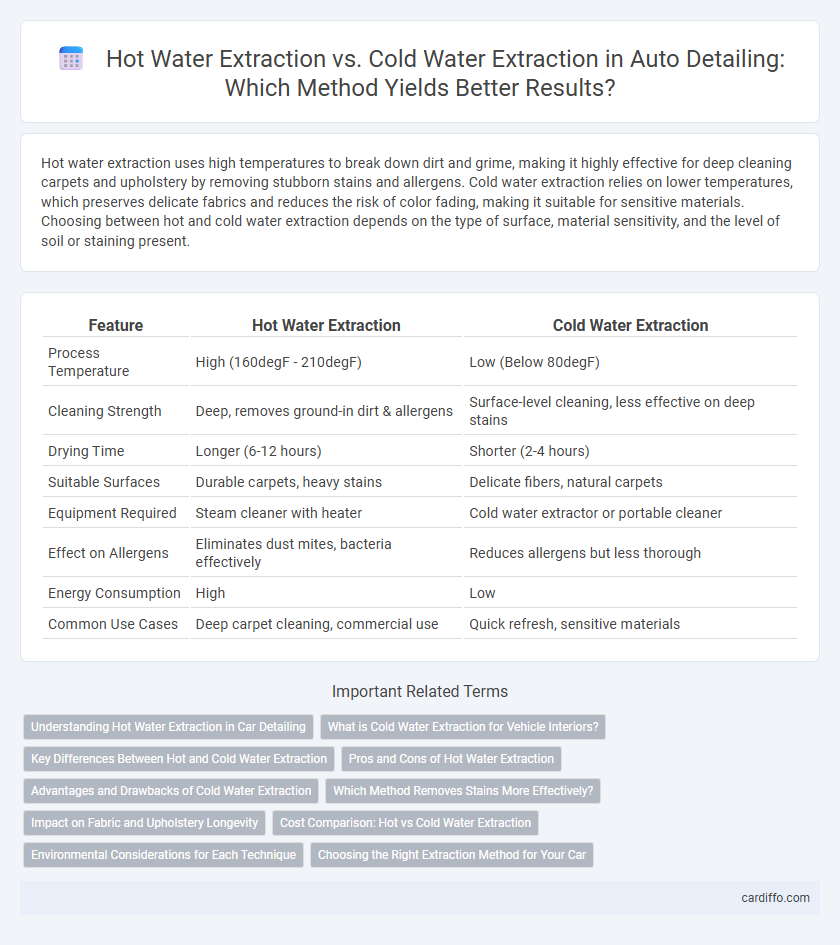Hot water extraction uses high temperatures to break down dirt and grime, making it highly effective for deep cleaning carpets and upholstery by removing stubborn stains and allergens. Cold water extraction relies on lower temperatures, which preserves delicate fabrics and reduces the risk of color fading, making it suitable for sensitive materials. Choosing between hot and cold water extraction depends on the type of surface, material sensitivity, and the level of soil or staining present.
Table of Comparison
| Feature | Hot Water Extraction | Cold Water Extraction |
|---|---|---|
| Process Temperature | High (160degF - 210degF) | Low (Below 80degF) |
| Cleaning Strength | Deep, removes ground-in dirt & allergens | Surface-level cleaning, less effective on deep stains |
| Drying Time | Longer (6-12 hours) | Shorter (2-4 hours) |
| Suitable Surfaces | Durable carpets, heavy stains | Delicate fibers, natural carpets |
| Equipment Required | Steam cleaner with heater | Cold water extractor or portable cleaner |
| Effect on Allergens | Eliminates dust mites, bacteria effectively | Reduces allergens but less thorough |
| Energy Consumption | High | Low |
| Common Use Cases | Deep carpet cleaning, commercial use | Quick refresh, sensitive materials |
Understanding Hot Water Extraction in Car Detailing
Hot Water Extraction in car detailing utilizes high-temperature water combined with specialized cleaning solutions to penetrate deep into fabric fibers and effectively remove embedded dirt, stains, and allergens. This method enhances the thoroughness of interior cleaning by softening soils and agitating debris, leading to superior stain removal compared to cold water techniques. The elevated temperature also aids in sanitizing surfaces, ensuring a more hygienic and refreshed vehicle interior.
What is Cold Water Extraction for Vehicle Interiors?
Cold water extraction for vehicle interiors is a carpet and upholstery cleaning method that uses low-temperature water combined with specialized detergents to remove dirt, stains, and allergens. This technique minimizes damage to delicate fabrics and prevents shrinkage or color fading often caused by hot water. Cold water extraction is especially effective for maintaining the integrity of leather, vinyl, and synthetic materials while enhancing the overall cleanliness and freshness of the vehicle's interior.
Key Differences Between Hot and Cold Water Extraction
Hot water extraction uses high temperature and powerful detergents to dissolve and remove deep-seated dirt and stains effectively from carpets and upholstery. Cold water extraction relies on lower temperatures and minimal chemical use, preserving delicate fibers and reducing the risk of dye bleeding or shrinkage. Hot water extraction typically delivers faster drying times, while cold water extraction prioritizes gentler cleaning for sensitive materials.
Pros and Cons of Hot Water Extraction
Hot Water Extraction excels in deep cleaning by penetrating carpet fibers with high-temperature steam, effectively removing dirt, allergens, and bacteria, making it ideal for heavy soiling and sanitization. However, it requires longer drying times, often 6-12 hours, which can risk mold growth if humidity is high or ventilation is poor. This method generally uses more water and energy compared to Cold Water Extraction, potentially increasing operational costs and environmental impact.
Advantages and Drawbacks of Cold Water Extraction
Cold Water Extraction in detailing offers the advantage of being a gentler cleaning method that reduces the risk of fabric damage and color fading, making it ideal for delicate materials and upholstery. It uses less water and energy compared to Hot Water Extraction, promoting eco-friendliness and faster drying times. However, Cold Water Extraction may be less effective in removing deep-set stains and heavy soil, often requiring multiple treatments or additional cleaning agents to achieve desired results.
Which Method Removes Stains More Effectively?
Hot water extraction, often called steam cleaning, utilizes high-temperature water mixed with cleaning solutions to penetrate deep into carpet fibers, breaking down and removing stubborn stains more effectively than cold water extraction. Cold water extraction relies on cooler temperatures, which may be gentler but lack the heat required to dissolve oils, dirt, and grime thoroughly. Professional detailing services favor hot water extraction for its superior stain removal and quicker drying times, making it the preferred method for deep cleaning carpets and upholstery.
Impact on Fabric and Upholstery Longevity
Hot water extraction effectively removes deep-seated dirt and allergens, preserving upholstery fibers and extending fabric longevity by preventing buildup that causes wear. Cold water extraction is gentler on delicate fabrics, reducing the risk of shrinkage and color fading, which supports maintaining the structural integrity of upholstery over time. Choosing the appropriate method based on fabric type maximizes both cleanliness and durability, safeguarding upholstery investment.
Cost Comparison: Hot vs Cold Water Extraction
Hot water extraction typically incurs higher costs due to increased energy consumption and longer drying times compared to cold water extraction. Cold water extraction often reduces utility expenses and labor time by utilizing lower temperatures and faster drying processes. Evaluating these factors helps businesses optimize detailing budgets while maintaining cleaning quality.
Environmental Considerations for Each Technique
Hot water extraction uses heated water and detergents to deep clean surfaces, consuming more energy and potentially releasing chemical residues into wastewater, raising environmental concerns. Cold water extraction relies on lower temperatures and biodegradable agents, reducing energy consumption and minimizing ecological impact but may require more frequent applications for effective cleaning. Choosing between these methods depends on balancing energy efficiency and the environmental effects of detergent runoff.
Choosing the Right Extraction Method for Your Car
Hot water extraction effectively removes deep-seated dirt and stains from car upholstery by using high-temperature steam combined with cleaning agents, making it ideal for heavily soiled interiors. Cold water extraction offers a gentler approach, preserving delicate fabrics and preventing shrinkage while still lifting surface-level dirt and allergens. Selecting the right extraction method depends on fabric type, stain severity, and drying time requirements to ensure optimal car detailing results.
Hot Water Extraction vs Cold Water Extraction Infographic

 cardiffo.com
cardiffo.com